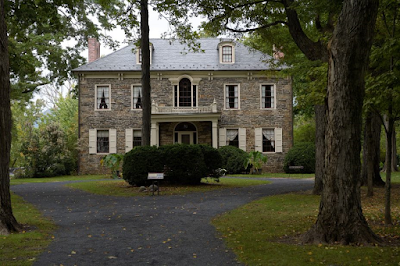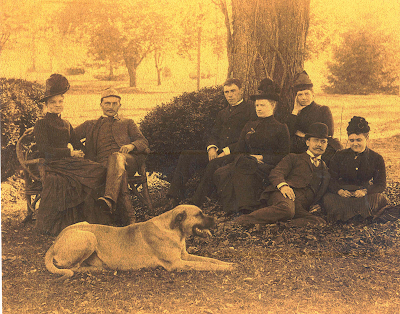During these recent pandemic months of living,
working, and finding entertainment in our homes it is hard to imagine a time
before the internet, television, and cell phones existed. Have you ever wondered what people from other
eras did in their free time? Unlike us, peoples from other centuries had very
little free time unless they were among the wealthy of society.
The Fort Hunter site (36Da159) in Harrisburg, Dauphin County, is one of the few places where we can get a more complete look into the types of entertainment enjoyed by people of another time. We can see this through a combination of historic documents and photographs and the objects we have recovered from the archaeological excavations at the property.
 |
Fort
Hunter Mansion
Many photographs show the Reilys enjoying time with
their friends around the property, including several of them playing badminton
in the side yard of the house. Some of you may recognize this area as the
location that the Pennsylvania Historical and Museum Commission, the State
Museum, has been exploring through archaeology for the past decade.
 |
John
and Helen Reily and guests (circa 1890s) playing badminton in the side yard of
the house |
During the Victorian (1837-1901) and Edwardian (1901-1910/1914)
periods, games that could be played in the yard were popular. Badminton (or
shuttlecock), lawn bowling, croquet, tennis, and other games were played by
both men and women. An afternoon could easily be spent engaged in throwing
horseshoes, many of which have been found in the yard. Meanwhile, children may
have played with marbles, jacks, or dolls, or emulated their elders by playing
many of the same yard games.
All of this exercise in the yard would have worked up the guests’ appetites. Many food and drink-related artifacts have been recovered from the yard area and the area around the outbuildings behind the mansion house. Dishes and utensils, drinking glasses, beer and ginger beer bottles, and food remains including large amounts of oyster and clam shell suggest the possibility of a party or picnic on a nice summer day.
 |
Beer
bottles, dishes and utensils, drinking glasses, and remains of food have been
found in the yard area
 |
Clay
pigeon pieces and brass shell casing |
We also know that the Reilys had a cabin on their
property north of the main farm in the area now covered by the Harrisburg
Country Club. Accounts indicate that they spent time there, likely hunting in
the woods and fishing from the creek.
The Reilys also enjoyed taking care of their farm animals and their beloved house pets, of which they had many over the years. During their time at Fort Hunter, Helen and John had numerous dogs of all shapes and sizes, a parrot, and a macaque (an Old-World monkey), as well as a very large hog, dairy cows, poultry, and prize horses. Not only do we have the photographs that show these animals but we also have proof from the ground itself. Excavations near the house have produced several Dauphin County dog tags and the skeletons of two dogs were recovered behind some of the outbuildings in the yard.
 |
1920s
Dauphin County dog tag recovered from excavations at Fort Hunter
 |
A
gathering at Fort Hunter with one of the Reily’s pet dogs |
Many other pictures and descriptions of the Reilys
with their animals show the amount of time they spent taking care of them and
enjoying their company. Horses were especially important to both Helen and
John, as Helen became an accomplished rider as a young girl and John showed off
his driving skills in an expensive carriage with a matched team. As noted
above, horseshoes have been found in the yard around the house.
Hopefully this blog illustrates the importance of
matching historic archaeological finds with research. Although what comes out
of the ground is important in itself, sometimes finding that photograph or
first-hand account can give you a bigger picture of the site and assist in the
understanding of the events that took place there. A unique connection to the
past and the individual who left the tangible evidence of their activities is
felt when you locate a photograph showing an object that you have pulled from
the ground.
Learn more about the Reilys and their
time at Fort Hunter or take a tour of the mansion house. Inside the mansion you will find a great
assortment of furniture, clothing, children’s toys, and other vestiges of their
lives at Fort Hunter. As well, their archives contain hundreds of photographs,
documents, and artifacts that document the lives of generations of people who
lived and worked at Fort Hunter. To learn more about our excavations and
findings at Fort Hunter, search this blog. See additional images of activities of the Reily family
Please continue to follow us through these weeks as we continue to work from home and stay safe! Remember to visit our on-line collections to view some of the artifacts recovered from Fort Hunter and learn more about their connection to the occupants of this site.
No comments:
Post a Comment